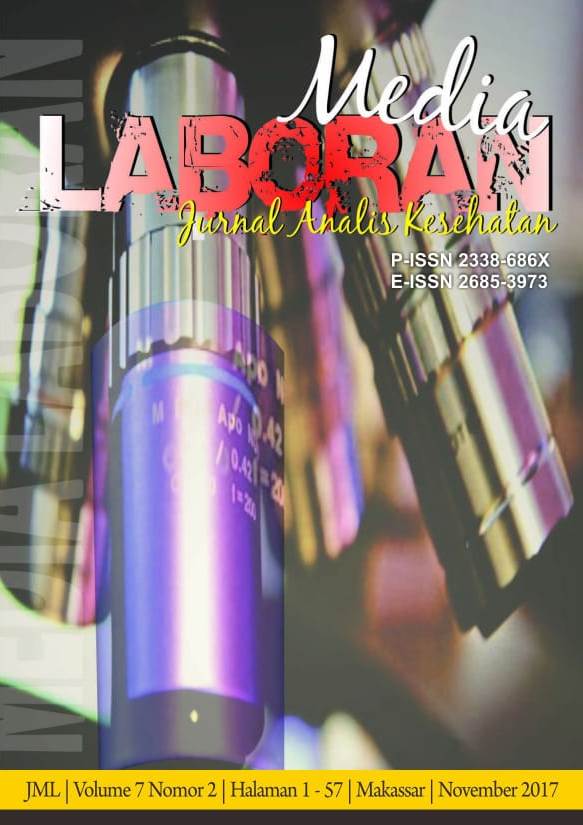Identifikasi Telur Soil Transmitted Helminths Pada Lalapan Mentimun Di Warung Makan Jalan Abdul Kadir Kota Makassar
Abstract
Soil Transmitted Helminths are intestinal nematodes which in their life cycle require soil for the ripening process. Worm problems associated with this worm infection are still commonly found. The rate of contamination of Soil Transmitted Helminths in vegetables is also still quite high. The process of processing and washing raw vegetables is not ready to eat, making it easier to transmit worm eggs to humans. Cucumber is one suitable substrate because it is often used as fresh vegetables. The purpose of this study is to determine the presence or absence of Soil Transmitted Helminths eggs in cucumber vegetables at food stalls in Jalan Abdul Kadir, Makassar City and the benefits of this research as information for the public about eggs Soil Transmitted Helminths that have an impact on the health problems of the human body. The type of research conducted is descriptive laboratory observation, which is to carry out laboratory tests to identify the Soil Transmitted Helminths eggs in cucumber vegetables at a food stall in Jalan Abdul Kadir, Makassar City. From the analysis of 10 samples of Cucumber vegetables, it shows that in the sample code (A), (B), (C), (D), (E), (F), (G), (H), (I), and (J), negative. So it can be concluded that there is no contamination of Soil Transmitted Helminths eggs in 10 samples of cucumber vegetables that have been studied. Suggestions to the public to remain careful in choosing or processing cucumbers which will be used as vegetables.
References
Depkes RI. 2010. Penyakit Kecacingan di Indonesia. Jakarta.
Direktorat Jenderal PP&PL Kemenkes RI, 2013. Profil Pengendalian Penyakit dan Penyehatan Lingkungan Tahun 2012. Kementrian Kesehatan Republik Indonesia. Jakarta.
Endriani, Mifbakhudin, Sayono, 2010. Beberapa Faktor yang Berhubungan Dengan Kejadian Kecacingan Pada Anak Usia 1-4 Tahun. Universitas Muhammadiyah Semarang.
Gani, H. E, 2002. Helmintologi Kedokteran. Edisi XX. EGC. Jakarta.
Gandahusada, S., dkk. 2006. Parasitologi Kedokteran. Balai Penerbitan FKUI, Jakarta.
Gandahusada. S., 2006. Parasitologi Kedokteran. Edisi II. FKUI. Jakarta.
Haryanto E, Suhartini T, Rahayu E, Sunarjono H. Sawi dan selada.Cetakan ke-7. Jakarta: Penebar Swadaya; 2007.
Kementerian Kesehatan RI. 2006. Keputusan Menteri Kesehatan Rupublik Indonesia Nomor 424/MENKES/SK/VI/2006 Tentang Pendoman Pengendalian Cacingan. Kementrian Kesehatan Republik Indonesia. Jakarta.
Lingga L. Cerdas memilih sayuran. Jakarta:AgroMedia pustaka; 2010.
Rubatzky, Vincent E., dan Mas Yamaguchi.2006. Sayuran Dunia.
Mardiana D, 2008. Prevalensi Cacing Usus Pada Murid Sekolah Dasar Wajib Belajar Pelayanan Gerakan Terpadu Pengentasan Kemiskinan Daerah Kumuh di Wilayah DKI Jakarta. Jurnal Ekologi Kesehatan Vol. 7 No. 2, Agustus 2008.
Onggowaluyo, S. 2002. Parasitologi Medik I Helmintologi. Cetakan I. EGC. Jakarta.
Sandjaja B. Helmintologi Kedokteran. Jakarta: Prestasi Pustaka; 2007.
Slamet, S.J. 2002. Kesehatan Lingkungan. Gadjah Mada University Press, Yogyakarta.
Sunardjono H. Bertanam 30 jenis sayuran. Jakarta: Penebar Swadaya; 2010.





